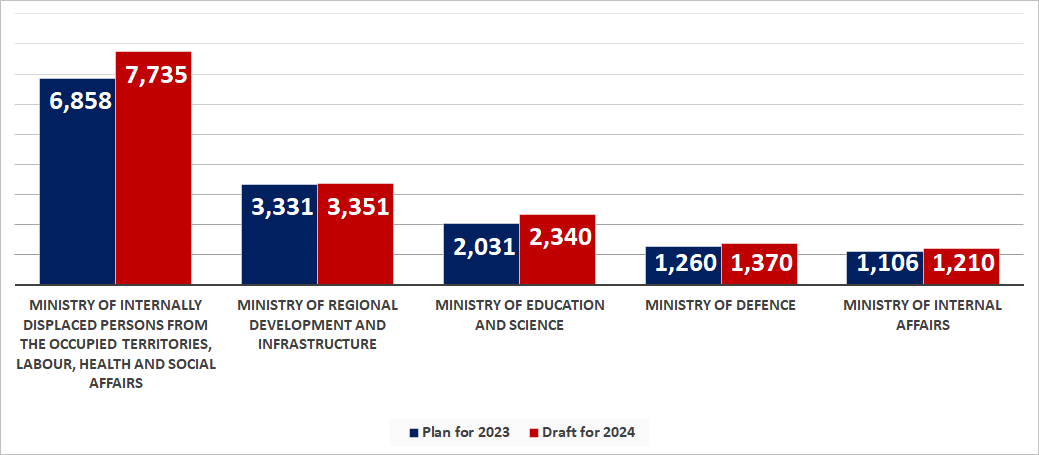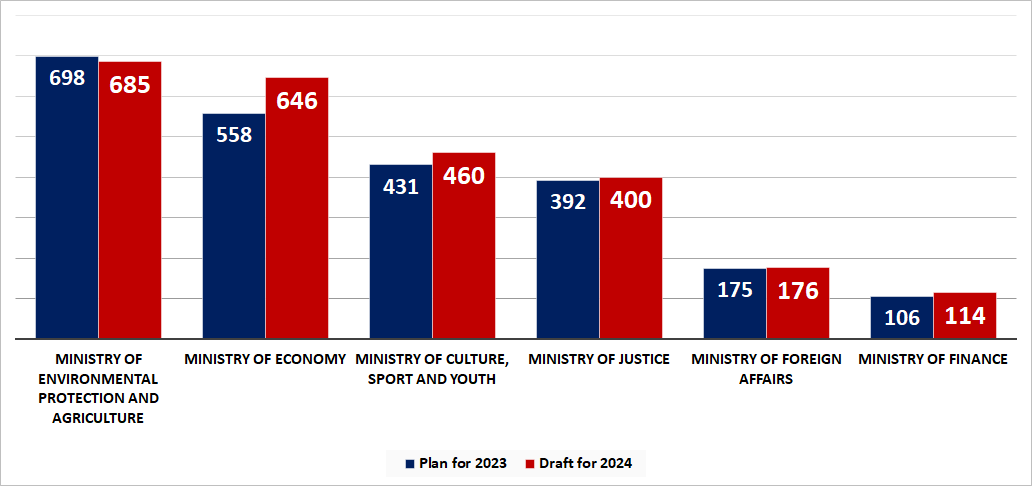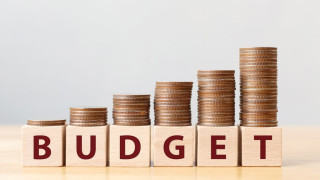The Ministry of Finance submitted the initial version of the 2024 state budget to the Parliament of Georgia. The budget is planned with a 5.2% economic growth rate whilst the estimated inflation is 3%, the budget deficit is 2.5% and the government debt to the GDP ratio is 38.2%. The amount of the common budget, which also includes the budgets of the autonomous republic and municipalities, will reach GEL 27.8 billion and spending of the central budget (payables) is set at GEL 24.2 billion.
This major financial document of the country should be adopted by the third Friday of December and funding for certain directions will be changed before that, although the priorities will most likely remain intact. The Ministry of IDPs from the Occupied Territories, Labour, Health and Social Affairs will have the biggest increase in funding by GEL 877 million with the total budget reaching GEL 7.735 billion.
Budget revenues will be GEL 23.9 billion. Of this amount, incomes are 83% - GEL 19.9 billion, loans are GEL 3.5 billion (GEL 2 billion external debt and GEL 1.5 billion internal debt), privatisation is GEL 200 million and the decrease in financial assets is GEL 300 million.
In accordance with the draft 2024 budget, the share of taxes in revenues is GEL 18.3 billion which is GEL 2 billion more as compared to the planned amount for the 2023 budget. GEL 261 million will be attracted from grants and other revenues and amount to GEL 1.3 billion.
In total, 92% of budget revenues are either taxpayer money or loans which will be paid by taxes in the upcoming years.
Graph 1: Structure of the Draft State Budget’s Revenues

Source: Ministry of Finance of Georgia
There are six taxes in Georgia and five of them are channelled to the state budget whilst property tax is paid to the municipalities. The VAT is the biggest in terms of volume, followed by income tax. Since Georgia has free trade agreements with most of its top trade partners, the share of the import tax is less than 1% in total tax incomes.
According to the draft budget, tax collection increases in the case of all five taxes. The only case when collection decreases is other taxes. In total, the Government of Georgia expects to collect 12.5% more tax incomes in 2024 as compared to 2023.
Graph 2: General/Nationwide Taxes (GEL Million)

Source: Ministry of Finance of Georgia
The government distributes money accumulated from taxes and other revenues to various ministries and agencies. The priorities are determined by the course of the Government of Georgia and the situation in the country. In 2021, GEL 1.161 billion was spent on COVID management, although there are no funds allocated for it in 2024. On the other hand, if in 2022 the financing for the CEC amounted to GEL 34 million, it will surge to GEL 146 million in 2024. In addition to the fact that 2024 is an election year, the record increase in funding was also caused by the fact that voting is planned in an electronic format.
The CEC is still an exception and the main priority is the social direction. As compared to 2019, the total spending part of the budget has increased by 82%, including defence costs by only 66%, and the funds allocated for pension provision of the population by 101%.
Along with the growth in nominal pensions, the increase in the number of pensioners also leads to an increase in pension costs. If in December 2019 some 763,000 people received old-age pension, their number increased by 67,000 to 830,000 in September 2023.
Old-age pension has been differentiated since 2020; in particular, a pensioner under the age of 70 years receives a different amount than a pensioner above 70. At the initial stage, the difference was GEL 30 with the difference rising to GEL 100 according to the 2024 budget. Pension for persons under the age of 70 years increases by GEL 20 GEL to GEL 315 and by GEL 50 to GEL 415 for those over 70. In addition, GEL 20 will be further added to each age group in mountainous areas. Overall, GEL 520 million more will be allocated in 2024 for pensions as compared to 2023 with the total amount reaching GEL 3.9 billion.
GEL 150 million more will be spent for social assistance of targeted groups and total assistance will reach GEL 1.5 billion. In addition, the amount of money allocated for universal healthcare increases by GEL 150 million to a record-high of GEL 1.030 billion. The total budget of the Ministry of Internally Displaced Persons from the Occupied Territories, Labour, Health and Social Affairs will be GEL 7.735 billion.
The second largest spending institution in 2024 will again be the Ministry of Regional Development and Infrastructure. According to the draft budget, GEL 3.350 billion will be allocated for it. Of this amount, more than GEL 1.9 billion will be used for the improvement of road infrastructure, GEL 530 million for the restoration and rehabilitation of water supply systems and GEL 322 million for the rehabilitation of municipal infrastructure. A further GEL 341 million will be spent for the rehabilitation of schools and pre-school institutions and GEL 150 million for the improvement of tourist infrastructure.
The financing for the Ministry of Education and Science increases by GEL 310 million to GEL 2.350 billion, including a growth of appropriations for general education schools from GEL 1.116 billion to GEL 1.250 billion, for vocational education from GEL 87 million to GEL 98 million and for higher education from GEL 147 million to GEL 162 million.
In terms of financing, the Ministry of Defence is in the fourth place with an allocation of GEL 1.370 billion. Although this amount is a record-high in recent years, it is still below the figure of 2007 when GEL 1.495 billion was spent on defence. However, it should also be taken into account that GEL 230 million will be used for the development of defence capabilities whilst the remaining funds will be spent on salaries, logistics and improving the social and infrastructural environment.
The Ministry of Internal Affairs completes the top five billion-dollar spending agencies as its allocation is GEL 1.210 billion in 2024. Of this amount, GEL 920 million will be spent on public order protection and GEL 148 million on border protection.
Graph 3: Financing Plan for the Ministries (GEL Million)

Source: Ministry of Finance of Georgia
The funding increases for almost every other ministry except for the Ministry of Environmental Protection and Agriculture.
Graph 4: Financing Plan for Ministries (GEL Million)

Source: Ministry of Finance of Georgia
In addition to the ministries, the following institutions also receive financing from the budget: the Presidential and Government Administrations, the Parliament, the Prosecutor's Office, the courts, the CEC and the Patriarchate. In most cases, funding has increased.
Graph 5: Financing Plan of Some Spending Institutions

Source: Ministry of Finance of Georgia
In terms of percentages, the financing for the CEC increases the most whilst co-financing for the cumulative pension is the highest in terms of amount. In 2019-2022, GEL 832 million was spent on this system and the amount of money spent on the pension plan will reach GEL 1.572 billion in six years if the plan for 2023-2024 is fulfilled (there is a high probability that it will be fulfilled very close to the planned amount).
According to the law, the budget must be approved by the third Friday of December. Until then, it will be discussed by the committees in the Parliament and their comments will be sent to the Ministry of Finance. The Ministry will then return the processed version to the Parliament where discussions will start again. During this period, it is expected that the amount allocated to each agency will be adjusted, although radical changes are unlikely.







